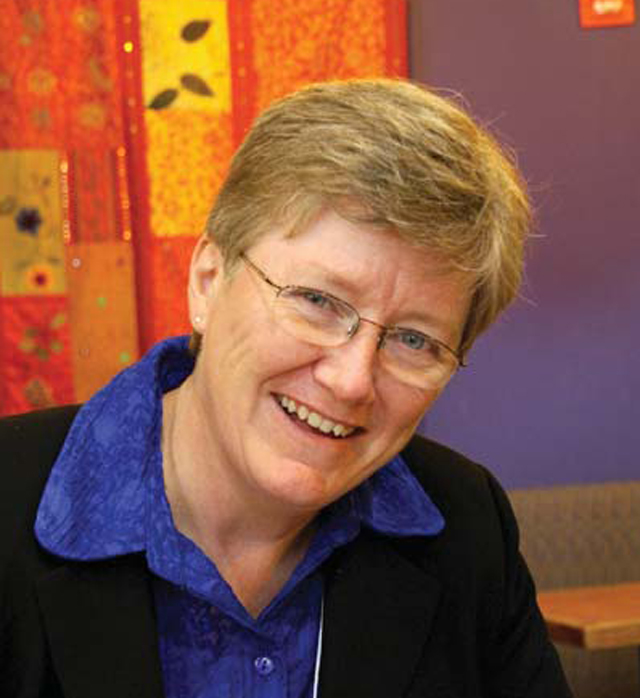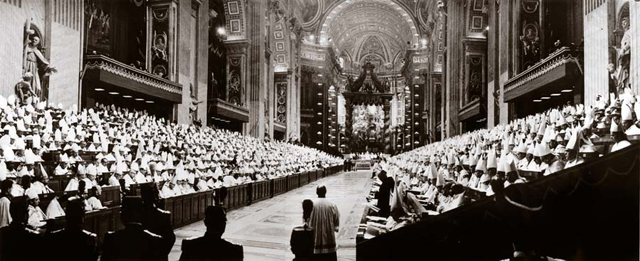VATICAN II…
Revisiting the Council
By Catherine E. Clifford
January/February 2012
Return to Table of Contents
Print Article
October 11, 2012, we will mark the 50th anniversary of the Second Vatican Council, a gathering of all Catholic bishops in Rome to deliberate on the life and teaching of the Church in four sessions of several months each from 1962 to 1965. Some 2,400 bishops, each representing their local church and bringing forward the pastoral needs experienced by the faithful in differing cultural contexts, were assisted by an impressive array of theologians and advisors. They were joined by more than 100 official observers representing other Christian churches. Most theologians and historians agree that this gathering was not only a decisive moment for the Catholic Church, but can be counted as the most important event in the last century of religious history, setting a new course for the relationship of the Catholic Church to other Christian churches, to other world religions, and to the modern world.
Those of a certain age may recall this time, and will have witnessed many important initiatives of renewal and reform in ecclesial life that have their roots in the teaching of Vatican II: revisions to the lectionary of readings for Sunday and weekday Mass; revised rites for the liturgical celebrations of the sacraments; increased participation of the laity in the life, prayer and ministries of the church. Yet, the meaning and importance of Vatican II are not obvious to everyone today. As the Jesuit historian and professor at Georgetown University John O’Malley observes, “For younger generations Vatican II can sound as remote as Trent [1545-63] and just as unfamiliar—one student defined it as ‘the pope’s summer residence.’” For them the council remains something in the distant past. Not having witnessed it directly, they remain unaware of the extent to which contemporary Catholicism has been and continues to be shaped by Vatican II.
Yet to be fully received
As we move further away from that decisive moment of the council in history, the risk increases that young and old alike lose sight of the many gifts offered in the council’s teaching—some of which have yet to be fully received—and of their potential to provide direction for the Church in the 21st century. One can rightly ask whether we have fully understood and embraced the council’s commitments to the centrality of the Word of God for the prayer and teaching of the Church; to the common dignity of all the baptized faithful; to the co-responsibility of all for the life and mission of the Church—a reality expressed as a common sharing in the priesthood of Christ; to the full, conscious and active participation of all in the prayer of the Church; to humble dialogue with other Christians, with people of other faiths, and with contemporary society and culture; and to undertaking whenever necessary that continual purification and reform of which the Church has need.
These key insights were to orient the Church as it sought to achieve the two primary goals laid out before the council fathers by Pope John XXIII in his historic opening speech given on October 11, 1962: the aggiornamento, or updating of the Church, and progress towards full ecclesial unity with other Christian Churches. Pope John understood that the Church has a perennial task of communicating the rich heritage of the Gospel tradition in terms that will be understood by contemporary men and women. To carry out its mission in the world, the witness of the Church must be persuasive.
This gathering was not only a decisive moment for the Catholic Church, but can be counted as the most important event in the last century of religious history, setting a new course for the relationship of the Catholic Church to other Christian churches, to other world religions, and to the modern world.
For these reasons, many Catholic theologians and historians see the context of the council’s 50th anniver-sary as an opportunity to give renewed attention to the study of the council and its teaching. With the passing of many who took part in Vatican II, new resources for study have become available memoirs, diaries, archives and other notes—providing us with a unique window into the experience of the council. They undertake this work not out of a nostalgic desire to return to the past, but with a desire to draw from this Spirit-filled moment in the life of the Church to meet the challenges of the present. Renewed study of the council can help us to ensure that its teachings are interpreted accurately and its insights are not lost. They continue to guide us to consider the many questions facing the Catholic Church in the 21st century.
Vatican II Research Centre
The new inter-university centre for research on “Vatican II and 21st Century Catholicism” established at Saint Paul University in Ottawa is one such initiative. It aims to promote collaborative scholarship and to support initiatives of pastoral renewal based on the study of the Second Vatican Council and contemporary Catholicism. Its members belong not only to Saint Paul University, but to the Faculté de théologie et de sciences religieuses at Laval University, the home of a research project on “Vatican II and Quebec in the 1960s,” and the Faculty of Theology of University of Saint Michael’s College, Toronto, which is developing a research initiative on Vatican II in English speaking Canada. In September of this year, these partners, in collaboration with Novalis-Bayard Publishers, will host an important conference on the theme, “Vatican II for the Next Generation.” The synergy generated by the collaboration of three of Canada’s most important faculties of Catholic theology will help to form young Catholic leaders and scholars equipped for creative engagement in the mission of the Church.
Fifty years is perhaps a short span in the long view of human history. Yet, this half-century has witnessed an unprecedented pace of social change and technological progress. The world of today is not that of the 1960s, and the Catholic Church of today is not the Church of 50 years ago. Over the last half century the global population has doubled and the Catholic Church has outpaced this rate of growth. Two thirds of Catholics now live in the southern hemisphere. Many questions confronting humanity and the Church in living out the Gospel in today’s world were not at all anticipated by the bishops of Vatican II. Nevertheless, the council’s teaching contains important insights into how we might respond to new challenges.
The Second Vatican Council was a moment of intense dialogue and self-reflection within the Church, one which led the Catholic community to opt for a new style or way of being “church” characterized by this dialogical engagement. The principal mode of living out the mission in the world of today is through dialogue. This was a key theme of Pope Paul’s first encyclical letter, Ecclesiam Suam, delivered in 1964, midway through the council’s deliberations. A mutual exchange is to characterize the mission of the Church as it proclaims the Good News with confidence, while humbly learning and readily drawing insights from new developments in human knowledge. The council’s Pastoral Constitution on the Church in the Modern World (Gaudium et Spes) captures this exchange when it speaks of the Church as the bearer of God’s Word that “draws religious and moral principles from it, but … does not always have a ready answer to every question” (#33). It recognizes that the Church must learn from the world: “from the experience of past ages, from the progress of the sciences, and from the riches hidden in various cultures, through which greater light is thrown on human nature and new avenues to truth opened up” (#44). The Church continues to evolve as a global community where the preaching of the Gospel is being adapted through this “vital contact and exchange between the Church and different cultures” (#44). Through this dynamic exchange we are enabled
Catherine E. Clifford is associate professor and vice-dean of the Faculty of Theology at Saint Paul University, Ottawa. She is director of the Centre for Vatican II and 21st Century Catholicism at St. Paul University, and co-author, with Richard Gaillardetz, of Keys to the Council (Liturgical Press, 2012).
Return to Table of Contents
Print Article

